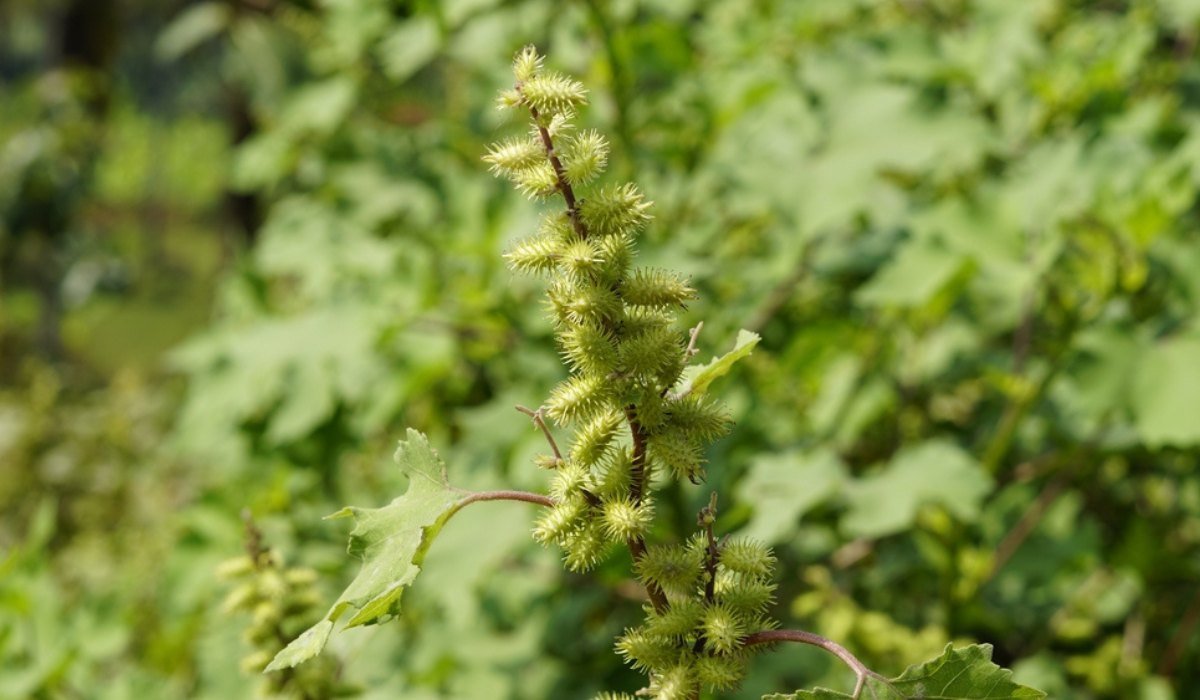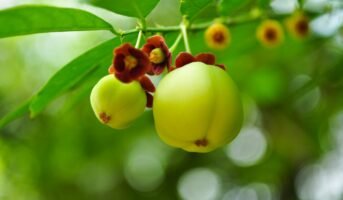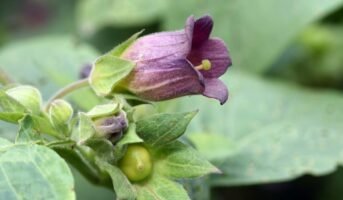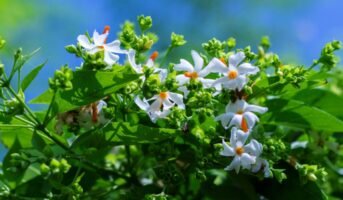The summer annual weed known as cocklebur is native to North America and has naturalized worldwide. It belongs to the daisy family. It can reach heights of 2-4 feet and prefers damp to wet sandy loams. It can’t flourish in total darkness.
Except for a few short side stems that grow from the leaf axils, they have very little branching. Similar to the racemes found in the leaf axils, the central stem terminates in a spike-like raceme.
Cocklebur is monoecious, meaning that each plant contains both male and female reproductive organs. The wind is used for pollination, while self-seeding is used for reproduction. Colonies are frequently created as a result of this.

Source: Pinterest
Xanthium strumarium: Key facts
| Common Name | Cocklebur, clotbur, common cocklebur, large cocklebur |
| Plant type | Herb |
| Native | United States of America |
| Family | Asteraceae |
| Natural Distribution | Between latitudes 53°N and 33°S, where it is most prevalent in the temperate zone but can also be found in subtropical and Mediterranean climates |
| Reproduction and dispersal | The seeds are spread by hairy farm animals, contaminated farm equipment, and waste soils. During the season of ploughing, oxen in western Kenya frequently carry large quantities of the prickly fruits from invading farms on their fur |
Xanthium strumarium: Genus
The plant belong to the Xanthium Genus, a class of flowering plant in the tribe Heliantheae from the sunflower family.
Xanthium strumarium: Native Habitat
Xanthium strumarium plant is generally associated with open and disturbed regions such as flood-prone regions where the soil has good moisture. The plant grows in varied habitats, including roadside, railway banks, overgrazed pastures, riverbanks, edges of ponds and freshwater marshes, and small streams. The soil where is grows well ranges from sandy to heavy clay soils. It grows to a great height and luxuriant appearance in the presence of rich soils as compared to poor soil conditions.
Xanthium strumarium: Care
Sun Tolerance
Keep the plant in sunlight or partially shades area.
Mature Height
The plant grows up to two metre in height. It reaches a good height in proper soil conditions.
Leaves
The leaves of Xanthium strumarium have alternate arrangement, with triangular or ovate outline. Leave colour is bright green.
Cold Tolerance
The plant is known to be drought-resistant and can also withstand a wide range of temperature, including cold.
Growth Rate
The Xanthium strumarium is known to have high reproductive capacity and rapid seedling growth.
Fruit
An elliptic two-chambered bur or seedcase covered with hooked prickles appears in the plant, containing two seeds. One grows in the first year while the other grows a year later.
Xanthium strumarium: Germination
The top seed seems to have a much longer dormancy period, whereas the bottom seed germinates within a year and keeps the plant present when things are going well. These long-lived seeds might remain dormant in the soil for several years before deciding to sprout.
This tactic probably ensured that cockleburs would be able to survive in any particular area for a long time before humans when disturbance regimes were a lot less frantic. Fast-germinating seeds might have been eliminated, but seeds kept in a seed bank could sprout when the right circumstances finally arose.
Xanthium strumarium: Problems
Xanthium strumarium is a serious weed of row crops like maize, groundnuts, cotton, and soya beans. It can also infiltrate pastures and grazing lands, reducing forage production. Most domestic animals are poisoned by it.
In South Africa, Xanthium strumarium has been designated as a noxious weed (a prohibited plant that must be controlled). They serve no economic purpose and have harmful properties to humans, animals, and the environment.

Source: calflora.org
Xanthium strumarium: Control methods
- The precise management measures taken for any plant invasion will be determined by factors such as terrain, labour cost and availability, the severity of the infestation, and the presence of other invasive species.
- Prevention is the most effective method of invasive species management. If prevention is no longer an option, it is best to treat weed infestations while they are still small to prevent them from spreading (early detection and rapid response).
- All control measures should aim to prevent seed formation. Small infestations and single plants can be hoed, while larger infestations can be sprayed with herbicide. Always read the label before using any herbicide and follow all instructions and safety precautions.
Xanthium strumarium: Medicinal uses
The entire plant is utilised as medicine, particularly the root and fruit. Ayurvedic medicine claims that Xanthium strumarium has cooling, laxative, fattening, anthelmintic, alexiteric, tonic, digestive, and antipyretic properties in addition to improving memory, appetite, voice, and skin. Leucoderma, biliousness, insect bite poisoning, epilepsy, salivation, and fever are all treated by it.
FAQs
What are the plant problems of Xanthium strumarium?
Their rapid growth can provide a concern for pastures, fields, roadside vegetation, vegetation along stream banks, dunes, and regions with poor drainage. The burs spread via short hooked prickles that latch onto clothing and animal fur. Young Cocklebur seedlings release poisonous compounds that can harm or even kill nearby plants by interfering with their germination.
Is Xanthium strumarium edible?
Cocklebur (Xanthium strumarium or Xanthium spinosum) plants produce prickly fruit (burrs) that cling to clothing and fur. Despite the fact that they resemble and taste like sunflower seeds, cocklebur seeds should never be eaten!
Housing News Desk is the news desk of leading online real estate portal, Housing.com. Housing News Desk focuses on a variety of topics such as real estate laws, taxes, current news, property trends, home loans, rentals, décor, green homes, home improvement, etc. The main objective of the news desk, is to cover the real estate sector from the perspective of providing information that is useful to the end-user.
Facebook: https://www.facebook.com/housing.com/
Twitter: https://twitter.com/Housing
Email: [email protected]











